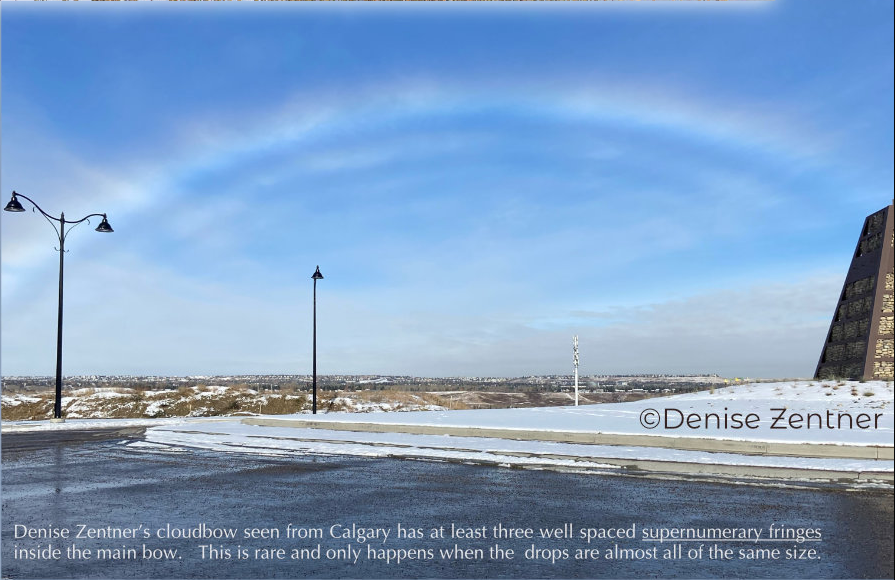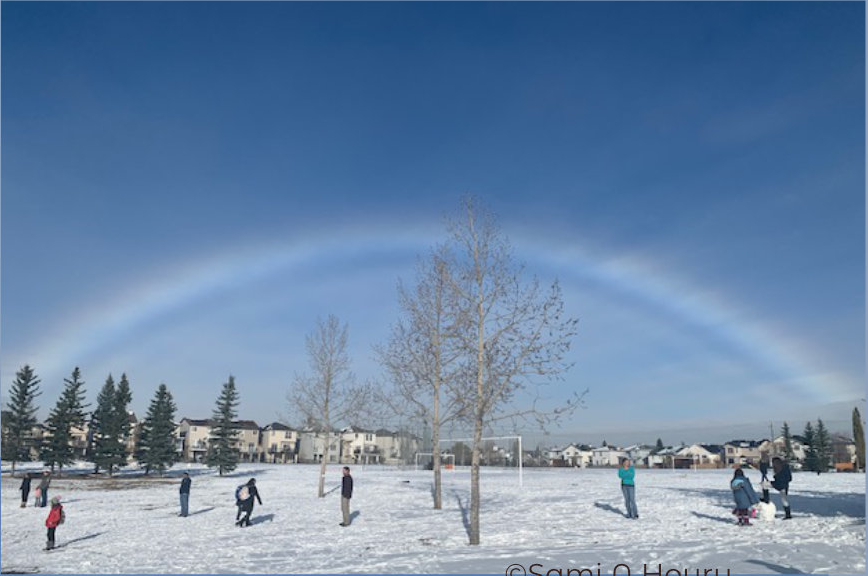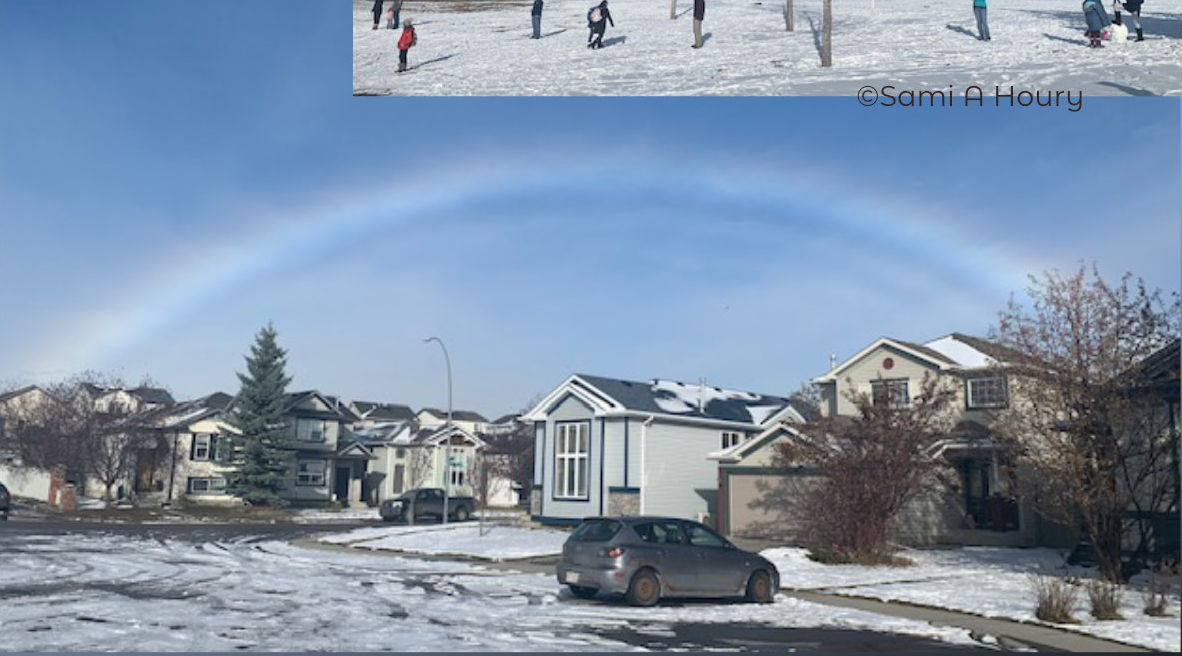Southern Alberta Cloudbows
Southern Alberta Cloudbows: A Phenomenon of Light and Water Droplets
Have you ever looked up at the sky and witnessed a breathtaking display of bright white bows? If you were in southern Alberta, Canada on October 27th, you may have had the privilege of experiencing this captivating atmospheric optics phenomenon known as cloudbows. Unlike traditional rainbows, cloudbows are broad and almost devoid of color, often appearing against a clear blue sky without any apparent rain. What makes them even more fascinating is that each person sees their own unique cloudbow, as each eye perceives a different bow.
Cloudbows are closely related to fogbows, but they lack the visible presence of fog or mist. Instead, these ethereal arcs are formed by the interaction of small water droplets suspended in humid air. The diffraction of light by these tiny droplets is what gives cloudbows their distinctive appearance. As light passes through the droplets, it undergoes diffraction, causing the rainbow colors to overlap and blur out, ultimately resulting in a beautiful white bow.
The Intriguing Characteristics of Southern Alberta Cloudbows
While cloudbows typically exhibit a uniform appearance, there are instances where they display unique features that make them even more extraordinary. For example, Denise Zentner captured a cloudbow seen from Calgary that showcased three well-spaced supernumerary fringes within the main bow. This occurrence is quite rare and only happens when the water droplets are nearly uniform in size.
Moreover, the size of the water droplets plays a significant role in shaping the characteristics of cloudbows. A comparison between a traditional rainbow formed by 0.8mm diameter drops and a cloudbow formed by much smaller 0.01mm drops in fog and clouds reveals an intriguing phenomenon. Decreasing the drop size not only broadens the bow but also weakens its colors, resulting in a more diffuse and ethereal appearance.
The Enigmatic Beauty of Fogbows and Cloudbows
Fogbows, a close cousin of cloudbows, also contribute to the enchanting world of atmospheric optics. These bows form under similar conditions but are typically observed when fog or mist is present. Sami Houry managed to capture a mesmerizing fogbow in Calgary that showcased dilute reds and yellows on the outside with inner blues, accompanied by two supernumerary fringes. This interplay of colors creates a captivating visual spectacle that adds to the enigmatic beauty of these atmospheric phenomena.
Exploring the Science Behind Cloudbows and Fogbows
Understanding the science behind cloudbows and fogbows allows us to appreciate the intricate processes that give rise to these ethereal displays. The formation of both bows relies on the diffraction of light by water droplets, but the absence or presence of fog or mist plays a crucial role in their distinct appearances. Here are some key points to consider:
- Cloudbows are formed by small water droplets in humid air, while fogbows require the presence of fog or mist.
- The diffraction of light by these droplets causes the overlapping and blurring of rainbow colors, resulting in the white appearance of cloudbows.
- The size of the water droplets affects the characteristics of both cloudbows and fogbows. Smaller droplets lead to broader bows and weaker colors.
- Supernumerary fringes, additional faint bands of color within the main bow, can occur when the droplets are nearly uniform in size.
- Fogbows often exhibit dilute reds and yellows on the outside with inner blues, creating a striking contrast of hues.
Captivating Moments in Southern Alberta's Skies
The occurrence of cloudbows and fogbows in southern Alberta's skies provides a captivating opportunity to witness the beauty and complexity of atmospheric optics. These elusive phenomena remind us of the delicate interplay between light and water droplets, resulting in stunning displays that captivate both the mind and the eye. So, the next time you find yourself gazing at the sky, keep an eye out for these ethereal bows, and allow yourself to be mesmerized by the wonders of our natural world.

Alberta Cloudbows
Bright white bows were in the skies of southern Alberta, Canada on 27th October. "Bows" in the plural because each person saw their own. In fact, each eye sees a different bow.
These were cloudbows. Broad and almost without colour, sometimes against a blue sky, with no obvious rain. They are the same as fogbows but without any visible fog or mist. Small water droplets in humid air make them.
The tiny drops diffract light which broadens the bow. The usual rainbow colours overlap and blur out to white.

Denise Zentner's cloudbow seen from Calgary has at least three well spaced supernumerary fringes inside the main bow. This is rare and only happens when the drops are almost all of the same size.

Rainbow to fogbow/cloudbow - drop size effect. At right a rainbow from 0.8mm dia. drops. At left, a bow from 0.01 mm drops in fog and clouds. Decreasing drop size broadens the bow and weakens its colours.

Below & Right: Sami Houry's fogbow seen in Calgary shows dilute reds/yellows outside with inner blues. There are two supernumerary fringes.

Note: this article has been automatically converted from the old site and may not appear as intended. You can find the original article here.
Reference Atmospheric Optics
If you use any of the definitions, information, or data presented on Atmospheric Optics, please copy the link or reference below to properly credit us as the reference source. Thank you!
-
<a href="https://atoptics.co.uk/blog/southern-alberta-cloudbows/">Southern Alberta Cloudbows</a>
-
"Southern Alberta Cloudbows". Atmospheric Optics. Accessed on November 26, 2024. https://atoptics.co.uk/blog/southern-alberta-cloudbows/.
-
"Southern Alberta Cloudbows". Atmospheric Optics, https://atoptics.co.uk/blog/southern-alberta-cloudbows/. Accessed 26 November, 2024
-
Southern Alberta Cloudbows. Atmospheric Optics. Retrieved from https://atoptics.co.uk/blog/southern-alberta-cloudbows/.